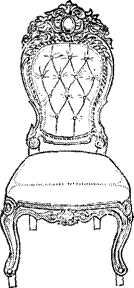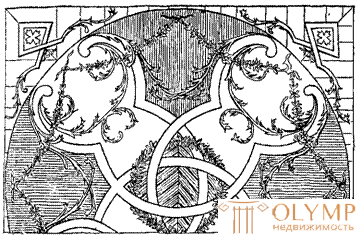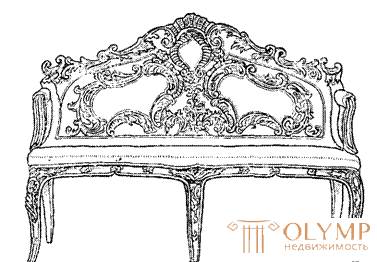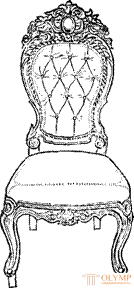
For architecture mid XVIII. characterized by the development of large palace urban and suburban complexes, both secular and ecclesiastical. To replace the small and modestly decorated interiors of the Petrine era come the enfilade of huge, richly decorated halls, wide grand staircase. Magnificent imperial residences are being created in Petersburg, Peterhof, Tsarskoye Selo. Classical orders are more widely applied, the figured pediment becomes the favorite motif, and the buildings both outside and inside are saturated with copious sculptural decoration.
For the interiors of this period is characterized by a comprehensive solution of all the constituent elements: wall decor, monumental painting of the ceiling, a variety of household items. Door and window openings are getting bigger, glazed doors lead to the park or garden, creating a direct connection between the interior and nature. Mirrors are widely used for maximum, even illusory, enlargement of the internal space, placing them against each other.
Wood carving continues to play a significant role in the interior, but asymmetrical construction, curvilinear ornamental forms, and dynamism are characteristic of carved compositions. To increase the richness of ornamentation and give the interior architecture a special festivity, carvings are gilded. The main elements of the carved decor were cartoons, volutes, allegorical female figures, sitting cupids, shells, intertwined with flower garlands, curls and flame-like motifs. Carved decor completely filled the walls, framed windows, doors and mirrors. Above the doorway is usually placed naddvernye panels.
Finishing the floor, made of parquet floor, on the contrary is distinguished by the severity of the pattern and creates a kind of artistic contrast with the lush and colorful solution of the walls and ceiling. Numerous Russian and foreign masters created the carved decoration of palace and church interiors together with the architects. The interiors of the Catherine Palace in Tsarskoye Selo by V. V. Rastrelli (1700-1776) are the most characteristic for this period. The main suite of the palace included the main staircase, a huge main hall, five main rooms. Rastrelli carried the main staircase to the edge of the building, which, firstly, contributed to the overview of the palace almost throughout its facade, and secondly, and most importantly, a continuous gold enfilade was created. The architectural effect grew gradually from the stairs to the Great and then from it to the Picture Hall. The length of the Great Hall is over 80 m, it is lit by eleven light doors on each side and so many upper mezzanine windows. The walls with windows have pilasters, between which mirrors are placed in fancy frames. Above the door passes the eaves, dismembering the hall into two tiers. The upper tier also included 'mirrors and windows in a lush frame, reminiscent of golden lace.
In the 60-70-ies of the XVIII century. architects are gradually moving away from the elegant pomp of the decorative design of buildings. The Chinese Palace in Oranienbaum (1762-1768) and the Marble Palace in St. Petersburg (1768-1785) by architect A. Rinaldi testify to a new classical direction in the development of Russian architecture. The Chinese Palace is designed as an intimate park pavilion and is an example of exotic hobbies in Russian architecture and decorative art. The palace received its name in the 19th century, since the three rooms were decorated in Chinese style, and among the collections there are a number of Chinese and Japanese items. The Chinese Palace includes both small and ceremonial halls, including the hall of the muses, the Great Hall and the Big Ki 'Thai Cabinet. All seventeen rooms of the Chinese palace are decorated with sculpture and painting. In their decoration are widely applied woodcarving, mosaic, gilding, artificial marble, glass beads. The walls and ceilings are painted in various soft, well-matched tones.

Fig. 1. Parquet in the Chinese Palace of Oranienbaum (Lomonosov, architect A. Rinaldi)
The remarkable parquet of the Chinese Palace is distinguished by the variety and complexity of the patterns, the color richness and subtlety of the set. Stylized plant forms (Fig. 1) in combination with geometric ones prevail in the floor patterns. They were made from various types of wood (mahogany, Persian walnut, boxwood, rosewood, amaranth, black eben, oak, maple, birch, hornbeam, oak, rosewood), using colors from light yellow and pink to dark brown and black In separate rooms there are up to fifteen breeds. Wooden plates with a thickness of 4 to 8 mm, cut in the shape of a picture, were fastened with fish glue to the boards making up the base, a smaller pattern was cut into large plates, and a thinner linear ornament was made on the surface of the plates by cutting or burning out.

Fig. 2. Sofa painted with gold (middle of the XVIII century.)
The interiors of the most significant architectural structures of the mid-18th century were fully or partially furnished with furniture made by Russian craftsmen. However, Western European furniture (English, mainly French) famous furniture makers of the time are widely used. Changes in the architectural appearance of the palace interior affected the forms of Russian furniture: it becomes cozier and more comfortable, less ponderous (Fig. 2), acquires soft and curvilinear outlines. Large and expressive motifs of furniture from the beginning of the 18th century. they are replaced by smaller, intricately intertwining patterns with fine modeling of individual parts. Furniture in character becomes close to the rococo style.
The main type of artistic decoration of furniture continues to be carving, performed both in relief and in openwork technique. Often furniture was almost completely covered with carvings, and the structural units were carefully masked with decor. The motifs of the carved decor are stylized flowers, branches with leaves, fruits, berries, shells, birds, etc.
A large place in the decoration of furniture began to occupy typesetting work of wood and inlays, performed first s in the form of individual inserts. In addition to the mosaic, the furniture was decorated with painting on colored lacquers, metal. Furniture was covered with a colorless varnish, and also gilded on a colorless or colored levkas and painted with oil or tempera paint on delicate tones (white, ivory, pink and gray-blue).
Upholstered furniture is covered with silk patterned fabrics - brocade, satin, specially made at the Russian tapestry factory, with piece drawings of floral character, velvet and colored leather.
The furniture for sitting did not differ a variety (fig. 3). The backs of the chair and chair were often pear-shaped. Upper part of the
zi backs decorated with carvings. The backs of the sofas were solid solid or consisting of three or four backs of chairs of the same shape, interconnected. Elastic, strongly bent legs, expanding in the upper part, smoothly connect with the binding and form a whole with it, the lower part of the legs is provided with a curl, put on the heel. Benches were made single and double, the seat was usually soft.
Tables differed a great variety of types and Solutions: toilet, writing-desk-bureau, decorative table-console. The lid, base and legs of the tables had curvilinear outlines. The rich carved decoration of the tsaru veil and the bearing parts of the console, the console table cover was made with mosaic decoration or trimmed with life stories, sometimes wood was replaced with colored marble with a beautiful texture. A clock, a vase, a lamp or a decorative sculpture was placed on the lid.

Fig. 3. Chair (middle of the XVIII e.)
The desk bureau had a number of shelves, sliding drawers, and sometimes a retractable writing board. The upper part of the table was closed with flaps or a semicircular cylindrical cover.
The beds were made with tall, figured tsargs. The edges of the boards were processed by the layout of a complex profile. The low legs of the beds (more massive than in other types of furniture) of a strongly curved shape are completely ornamented with carvings.
The chests were set on rather high legs, the lid was shaped, the sides were convex, the front side of the dresser was often decorated with a set or painting in colored lacquers.
The chimney screen, a carved frame on legs with a patterned fabric and embroidery stretched on it, comes into use in palace furniture.
Russian furniture products, despite the great similarity with European ones, also have significant differences: more free-form, softer in outline, carving is larger; traditional polychrome and combination of gilding with painting. These features are closely related to the general change in the nature of the architecture, which in the middle of the XVIII century. becomes more magnificent and solemn. An enfilade construction of the inner space and a desire to open it both real and illusory appears. In the decision of the interior is characterized by the unity of all elements. Free, asymmetric techniques of compositions both in the interior and in furniture prevail.
Что бы оставить комментарий войдите
Комментарии (0)